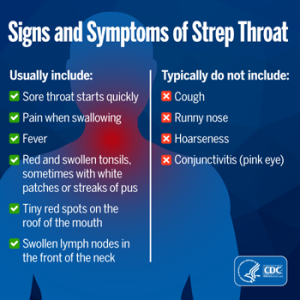You may have heard of the increase in strep throat spreading around schools, daycares and other places in the community. We’re here to help you understand what strep throat is, the signs to watch out for and what to do if you suspect your child might be infected.
What is strep throat?
According to the Centers for Disease Control and Prevention (CDC), “Strep throat is an infection in the throat and tonsils caused by bacteria called group A Streptococcus (group A strep).” The symptoms of strep throat include:
- Sore throat
- Pain when swallowing
- Fever
- Red and swollen tonsils
Some other symptoms that oftentimes show up in kids are: headache, stomach pain, nausea, or vomiting.
More from the CDC on the symptoms of strep throat:
What does scarlet fever have to do with strep?
Sometimes strep throat can cause something called scarlet fever. This happens when your child has a sore throat and then also develops a rash. Learn more about scarlet fever from the CDC.
What to do if you think your child has strep?
If you think your child may have strep throat, it’s recommended you get your child tested at their primary care provider’s office. They will run a lab test to confirm if your child has strep throat or if it is simply a sore throat perhaps due to other reasons like a viral process.
How long are they contagious?
If your child tests positive for strep, their health care provider will prescribe antibiotics to fight the infection. They may be contagious until 12 hours after they start their antibiotics.
How can you prevent your child from getting strep throat?
The way you can help prevent your child from getting strep throat are the same as preventing your child from getting sick in general. Here are a few best practices to help keep them healthy:
- Handwashing. Make sure your children wash their hands after using the bathroom, eating, going in public, coughing, etc. Learn more handwashing best-practices.
- Stay home when sick. If you or your child is sick, it’s recommended they stay home from group activities until they feel better.
- Avoid others who are sick. Respiratory droplets from someone who is sick can be spread through the air by talking, coughing, sneezing and more.
How does strep spread?
Strep can spread many ways, including:
- Through direct contact from someone who has strep
- On contaminated surfaces like a doorknob or a sink
- Through droplets in the air released while talking or during a cough or sneeze
- Having toothbrushes stored adjacent to one another
